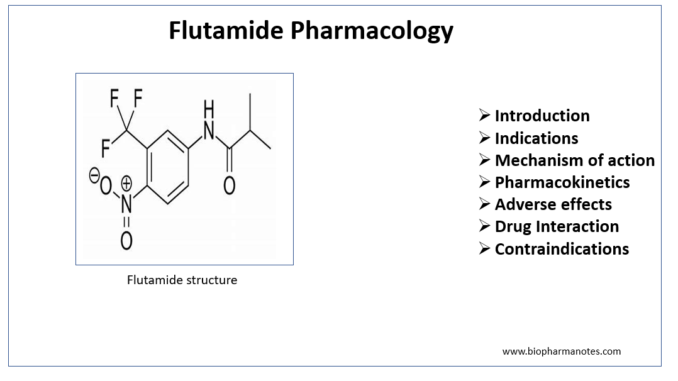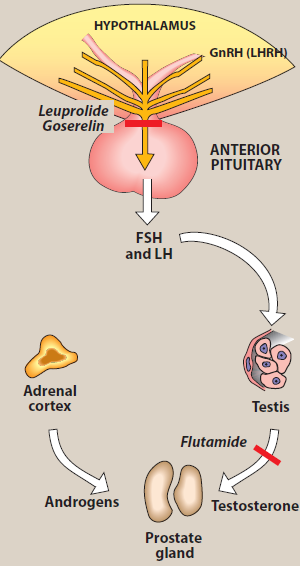
- Flutamide is non-steroidal anti-androgen compound used to treat prostate cancer. It is a toluidine derivative. Prostate cancer is most common type of cancer. Some prostate cancer grow slowly and are confined to prostate gland whereas some prostate cancer are aggressive and can spread quickly.
- It was first discovered in 1967 for use as an antibiotic. Later, researchers found its antiandrogenic property and it was introduced in medical use in 1983. In 1989, flutamide received FDA approval.
- It was first non-steroidal anti-androgen compound to be introduced. Another non-steroidal anti-androgen compound which are introduced later include nilutamide and bicalutamide.
Indications of flutamide
- It is used in combination with GnRH analogue to treat metastatic prostate cancer. It is approved by US-FDA for treatment of stage B2-C and stage D2 metastatic prostate cancer.
- There is some off-label use for treatment of hair loss, female hirsutism, polycystic ovarian syndrome and acne.
Mechanism of action of flutamide

Figure- Mechanism of action of flutamide (Source- Lippincott’s Illustrated Reviews)
- Flutamide binds to androgen receptor and block the binding of testosterone to androgen receptor. Hence, it decreases cell proliferation in androgen dependent tissue. In absence of testosterone, cancer cells cannot grow, and cell death occurs. Flutamide block action of both endogenous and exogenous testosterone.
- Concurrent administration with GnRH analogue help to prevent unnecessary effects like increase in plasma concentration of testosterone, estradiol, follicle stimulating hormone (FSH) and luteinizing hormone (LH).
Pharmacokinetics of flutamide
- It is administered via oral route. Its half-life is 6 hours so is administered 3 times/day to maintain adequate serum level.
- It undergoes hepatic metabolism mainly by CYP3A4 and other cytochrome enzymes like CYP1A2. Its active metabolite is 2- hydroxy- flutamide which is more effective anti-androgen compound. Both flutamide and hydroxyflutamide extensively bind to proteins (˃ 94%).
- It is mainly excreted in urine. Less than 5% is excreted in feces.
Adverse effects
- The most common side effect is gynecomastia (34 to 100%). It is less frequent when used in combination with GnRH analogue.
- It comes with black box warning due to risk of hepatic failure. The major metabolite hydroxyflutamide inhibit enzymes required for electron transport chain in hepatocyte mitochondria. This cause cessation of cellular respiration leading to cellular death. Patients having flutamide should undergo liver function test if any symptoms of hepatic failure are observed. The therapy should be discontinued if patient get jaundice or if level of alanine aminotransferase increases two times the upper limit of normal.
- It may cause some gastrointestinal discomfort including diarrhea, nausea and vomiting. It may cause impotency and decreased libido. Rashes, hot flashes, leucopenia, anorexia and edema may also occur.
Drug Interaction
- When used in combination with drugs which inhibit enzyme CYP3A4 including idelalisib, mitotane, tenofovir and ivacaftor, chances of serious side effects persist. Inhibition of enzyme CYP3A4 increase the level of flutamide in the body.
- It potentiates effect of warfarin and results in increased prothrombin time.
Contraindications
- Contraindicated in patients who are hypersensitive to flutamide. Contraindicated in patients with hepatic failure.
- It is contraindicated in patients with chronic depression.
References
- Flutamide Article (statpearls.com)
- Brogden RN, Chrisp P. Flutamide- A Review of its Pharmacodynamic and Pharmacokinetic Properties, and Therapeutic use in Advanced Prostate Cancer. Drugs and Aging. 1991; 1; 104-115.
- Sufrin G, Coffey DS. Flutamide- Mechanism of action of a new nonsteroidal antiandrogen. Investigative Urology. 1976; 13(6): 429-434.
- Pharmacology and Pharmacotherapeutics. 24th edition.
- Goodman and Gillman Manual of Pharmacology and Therapeutics.
- Lippincott Illustrated Reviews Pharmacology, 6th edition.